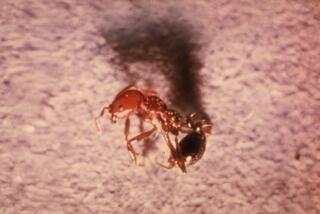Fire Ants Clone Themselves in a Battle of the Sexes, Study Shows
Male and female fire ants keep their gene pools separate by cloning themselves -- an unheard of genetic isolation of the sexes that may revise evolutionary rules, scientists reported this week in the journal Nature.
In an accompanying commentary, David Queller, a biologist at Rice University in Houston, wrote that male and female fire ants might represent two distinct species, rather than one.
Biologists analyzed DNA from the stinging insect Wasmannia auropunctata, commonly called the little fire ant. The ants were collected from nests found rolled up in leaves among the rain forests and coffee plantations of French Guiana on South America’s Caribbean coast.
Some of the queens’ eggs developed without male fertilization. These produced only females that shared identical genes with queens.
In the cutthroat world of evolutionary survival, this allows queens to promote 100% of their DNA to the next generation, rather than having half combined with male DNA.
Other eggs were fertilized by males and had genes from both sexes.
The worker ants that were exclusively produced from these eggs were sterile, unable to propagate their mixture of male and female genes to future generations.
But faced with such a dead end, the male genes in some of the fertilized eggs appeared to destroy the female genes. The ants from these eggs were clones of their fathers.
“It’s a selfish strategy, initiated by females,” said lead scientist Denis Fournier from Belgium’s Universite Libre de Bruxelles. “Males must adapt or disappear.”
This unusual system allows the stable propagation of queens -- specialized creatures that are largely protected from environmental stresses in their nests and do not need to be highly adaptable.
To adapt to changing conditions, the colonies depend on the more genetically diverse worker ants.
More to Read
Sign up for Essential California
The most important California stories and recommendations in your inbox every morning.
You may occasionally receive promotional content from the Los Angeles Times.









